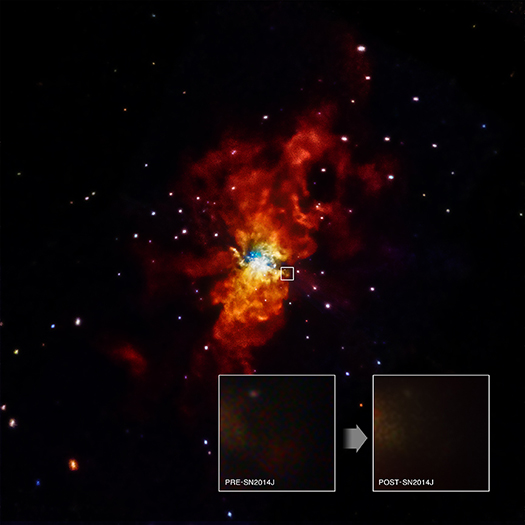For Release: August 14, 2014
NASA
New data from NASA's Chandra X-ray Observatory offer a glimpse into the environment of a star before it exploded earlier this year, and insight into what triggered one of the closest supernovas witnessed in decades.
The data gathered on the Jan. 21 explosion, a Type Ia supernova, allowed scientists to rule out one possible cause. These supernovas may be triggered when a white dwarf takes on too much mass from its companion star, immersing it in a cloud of gas that produces a significant source of X-rays after the explosion.
Astronomers used NASA's Swift and Chandra telescopes to search the nearby Messier 82 galaxy, the location of the explosion, for such an X-ray source. However, no source was found, revealing the region around the site of the supernova is relatively devoid of material.
"While it may sound a bit odd, we actually learned a great deal about this supernova by detecting absolutely nothing," said Raffaella Margutti of the Harvard-Smithsonian Center for Astrophysics (CfA) in Cambridge, Massachusetts, who led the study. "Now we can essentially rule out that the explosion was caused by a white dwarf continuously pulling material from a companion star."
This supernova, SN 2014J, could instead have been caused by the merger of two white dwarf stars, an event that should result in little or no X-rays after the explosion. Further observations could rule out or confirm other possible triggers.
"Being able to eliminate one of the main possible explanations for what caused SN 2014J to explode is a big step," said CfA's Atish Kamble, a co-author of the study. "The next step is to narrow things down even further."
Type Ia supernovas are used as cosmic distance-markers, and have played a key role in the discovery of the universe's accelerated expansion. At about 12 million light-years from Earth, SN 2014J and its host galaxy are close -- from a cosmic perspective. This offers scientists a chance to observe details that would be too hard to detect in more distant supernovas.
"It's crucial that we understand exactly how these stars explode because so much is riding on our observations of them for cosmology," said co-author Jerod Parrent also from CfA. "SN 2014J might be a chance of a lifetime to study one of these supernovas in detail as it happens."
The study of SN 2014J is similar to a study led by Margutti about another supernova, SN 2011fe, in the nearby galaxy M101.
This study was conducted by CfA's Supernova Forensics Team, led by Alicia Soderberg. The results were published online and in the July 20 print issue of The Astrophysical Journal.
NASA's Marshall Space Flight Center in Huntsville, Alabama, manages the Chandra program for NASA's Science Mission Directorate in Washington. The Smithsonian Astrophysical Observatory in Cambridge, Massachusetts, controls Chandra's science and flight operations.
For an additional interactive image, podcast, and video on the findings, visit:http://chandra.si.edu
For Chandra images, multimedia and related materials, visit:
http://www.nasa.gov/chandra
For a preprint of the study results in The Astrophysical Journal, visit:
http://arxiv.org/abs/1405.1488
Media contacts:
Felicia Chou
Headquarters, Washington
202-358-0257
felicia.chou@nasa.gov
Megan Watzke
Chandra X-ray Center, Cambridge, Mass.
617-496-7998
mwatzke@cfa.harvard.edu




Visitor Comments (7)
It was extremely revealing and educative for person like me interested in amateur astronomy.
Posted by Ranjit Banerjee on Monday, 11.10.14 @ 23:48pm
This article was amazing but how eruptions on the surface of a white dwarf can clean the environment? In addition, what are the closest stars or black holes to SN2014J? Can't they have a role to clean the space around this new supernova?
Posted by NASAFan on Wednesday, 09.10.14 @ 13:02pm
This article about SN 2014J was the most interesting article so far. I really enjoy these new findings about our wonderful Universe. Keep up the good work.
Mark T. Milhous
Posted by Mark Milhous on Monday, 08.25.14 @ 22:01pm
It is nice to see this image from a supernova so closer and to know more about this kind of star. Thank you for your information.
Posted by corleone graciela on Sunday, 08.17.14 @ 11:56am
It appears the small box on the right middle side may be the entry point of whatever caused the explosion. Blue is right across from this point.
What is the red spot in lower left?
Posted by Susan on Friday, 08.15.14 @ 19:23pm
Outstanding.
Posted by james garland on Friday, 08.15.14 @ 16:50pm
Hi folks, we are not there yet, but we are getting there. Keep up the great work.
Alan Soden.
Posted by alan soden on Friday, 08.15.14 @ 15:07pm